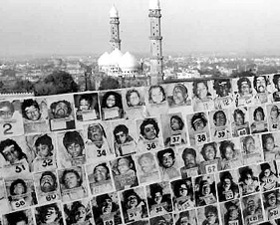Bhopal: Just four hours before the world’s worst industrial disaster took place, Inayat Mohammad had gifted his wife Bano Bee a sari. The 45-year-old man died that very night, perishing in the 1984 Bhopal gas leak. And his widow, now 60, has not worn the sari till date.
 That same night, Bismillah Bee had run madly, with her three-year-old son in her arms, fleeing the gas leakage. Badly affected by the fumes, she was told Sajjad is under treatment. Only after 40 days did she come to know that her son had died in her lap.
That same night, Bismillah Bee had run madly, with her three-year-old son in her arms, fleeing the gas leakage. Badly affected by the fumes, she was told Sajjad is under treatment. Only after 40 days did she come to know that her son had died in her lap.
Bano Bee’s sari, Sajjad’s sweater and pants, the walking stick of one Hafiza Bee’s husband, an army medal, a bridal dress, a mangal sutra, wooden legs, bangles, milk bottle, spectacles and a pencil box will be kept in India’s first People’s Museum being developed in Bhopal.
Along with these objects, the survivors of the gas tragedy will narrate their own story. There would be a headphone and visitors will not only see the objects displayed but also hear the story of a particular victim or survivor.
However, it would not be a government-built effort, but a community-run museum with the concept of “nothing about me, without me.”
“The Madhya Pradesh government is also working on a museum on gas tragedy, but neither have survivors been asked nor have they any idea how it is being built. And the biggest thing – the government has no moral right to memorialise because it is complicit in the injustice meted out to the community,” Satinath Sarangi of the Bhopal Group for Information and Action said.
On the intervening night of Dec 2-3, 1984, tonnes of poisonous methyl isocyanate had leaked from the then Union Carbide factory in Bhopal, killing over 3,000 lives instantly, around 25,000 over the years and affecting around 500,000 people, according to victims.
As the fight for justice presses on after 27 years, objects related to the movement like chains and locks, rakhis, posters and banners will also be exhibited.
The survivors are now developing their own travelling exhibition, which they hope will be a permanent museum in the city later. A trust, Remember Bhopal Trust, has been set up for the museum. The survivors have enlisted Rama Lakshmi, a museologist, who has worked on two such projects in the United States.
Rama Lakshmi said, “The museum exhibiting a people’s movement is being built for first time in the country, although in many Western countries we find many museums telling the stories of social movements.”
She shares that museums are “safe sites for unsafe ideas.” They can wrestle with history, identity, conflict and aspirations in a way that books, films and plays cannot – like the provocative exhibition on race in the US, the Apartheid Museum in South Africa and the Holocaust museums around the world.
“A museum at the Bhopal Union Carbide site can help us understand everything that is wrong and right with contemporary India, and how our social movements articulate demands for justice,” the museologist said.
Rama Lakshmi, who has been working on the project since January this year, comes to Bhopal every month from Delhi and spends a week here. The museum project has also brought together survivors and activists who are fighting for justice under different banners.
“For a good future, the past should be remembered. Unfortunately, we are forgetting the past and the government wants that either we do not remember it or we remember it as they want. But with such a museum, we would be able to preserve our past,” Abdul Jabbar of the Bhopal Gas Peedith Mahila Udyog Sanghathan said.
The travelling museum will be ready by April 2012.
“The bus, which will have different objects, photographs and recorded stories along with several other things, will also have survivors inside it. It will not only tell stories of the survivors through objects but survivors will also be present as a fact,” Rama Lakshmi explains.
The museologist informs that in April, the bus will be in Bhopal for a one month. Later, for a year it will tour the country. In every city, it will stop in the evening and cultural programmes will be presented by artists on the tragedy.
After 12 months, when it returns to Bhopal, a permanent museum will be commemorated.
“Because it will be a travelling museum, not only will it reach directly to the people of India but will also connect with several other movements going on in the country. We not only want the empathy of the people for the survivors but that they take inspiration from their ongoing incredible fight for justice,” Rama Lakshmi adds.
Source: Zee News India


